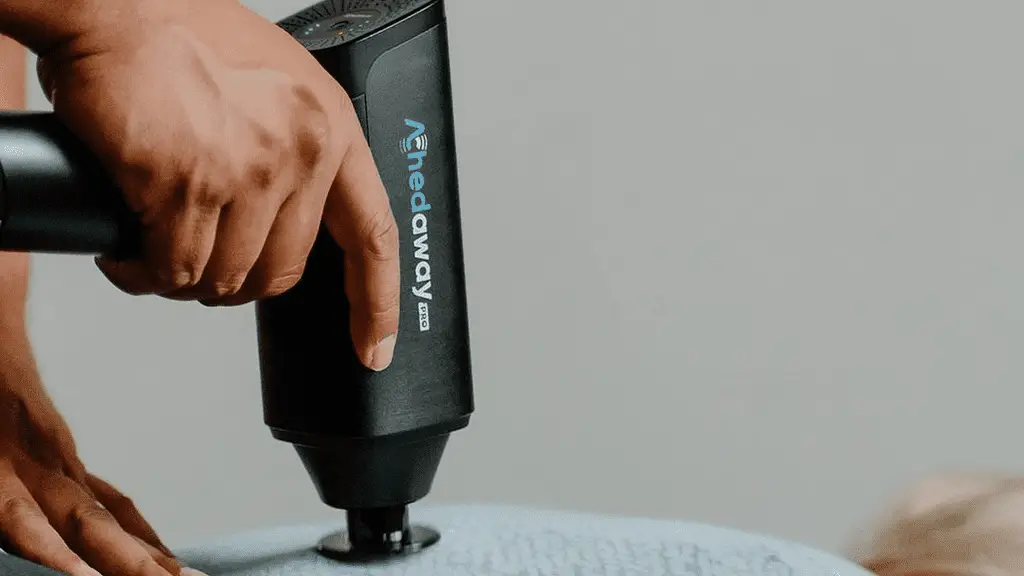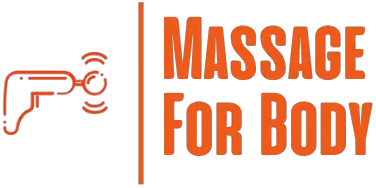Possible reasons why you might be saddled by lower back pain are numerous and range from muscle strains to herniated discs.
No matter what your case is, the suffering is very real, so you might be wondering how to use a massage gun on the lower back to relieve your condition. This article explores the safety of such an undertaking and offers helpful tips on percussive therapy for back pain. Read below to learn how to use Theragun on your back by yourself and whether it’s a good idea to do so at all.
Contents
Massage Gun for Back Pain Guide
The key to using a massage gun effectively on your lower back is to only apply it to specific muscle groups for no longer than 2 minutes at a time, although you can have multiple sessions a day. Avoid applying percussion therapy to injured spots and be sure to consult a doctor in case of chronic conditions.
What is a massage gun?
The term “massage gun” refers to a handheld device, usually electric, that generates percussion for topical application. That is, it doesn’t merely vibrate against your skin but “kneads” the muscles deeper inside your body, improving the blood flow as well as the circulation of lymph.
Such deep tissue massage offers a number of benefits for the muscles. In particular, it prevents microscopic tears in the muscular tissue that often occurs when you strain your muscles without a proper warm-up. Relaxation post-exercise is another benefit you can enjoy as a dedicated athlete or someone who’s just active in their daily life.

How to use a massage gun on the lower back step by step
This section explains massage gun attachment uses for the lower back area as well as some precautions that you need to take in order to stay safe without compromising effectiveness. We’ll focus on performing the task on your own, but there’s nothing to prevent you from asking a friend. The reason we underscore the ability to perform the massage on your own is that it’s probably the most valuable benefit of a well-designed tool such as Theragun or another quality brand: you don’t have to rely on anyone else. Even when it comes to the lower back, the single-handed operation is often supported in advanced models.
Self-massage with a massage gun
Here are the steps to take if you want to give your lower back a deep massage with a device designed specifically for this purpose.
- Identify the purpose of the session. Make sure you are not trying to cure a medical condition without consulting a doctor first; only resort to self-massage to relieve muscle pain caused by everyday strain and rigorous physical routines.
- Depending on the area that you want to cover, choose the attachment that best fits the purpose. Fork-shaped and large ballpoint attachments are the most popular choices for the lower back.
- Start massaging the area at the lowest speed/intensity setting.
- Increase the intensity as necessary.
- Move the attachment gently across the area to increase the effect.
- Limit the duration of each session to 1 minute for muscle activation prior to a workout or 2 minutes when you need relaxation.
How often should you use a massage gun on the lower back?
It’s never a mistake to use a massage gun before you engage in any physical exercise, and the lower back is no exception. It also works wonders in terms of relaxation. Try it post-workout to reduce muscle swelling and get a refreshing sleep the following night.
Massage guns: the best lower back pain relief
A massage gun won’t solve every lower back problem that might be causing pain, but it does relieve very common conditions such as excessive muscle strain or tears due to poor warm-up. It is an affordable remedy that you can use on your own any time you want, and it’s very easy to master. Self-massage with a massage gun is highly recommended for non-acute lower back pain where the cause is not a contraindication for percussion therapy.
Lower Back Massage FAQ
This section offers brief answers to some commonly asked questions when it comes to using your new Theragun for back pain. Feel free to share your experience or ask questions in the comments section as well.
Can massage guns be harmful?
Not as such. However, you might hurt yourself inadvertently if you don’t follow the simple safety principles described above. In particular, applying the gun to areas where there’s not much muscle tissue or to recently hurt spots is almost always a bad idea (see below for more details). It’s also important to limit the duration of such percussion therapy. Myths such as spreading cancer cells while using a massage gun have nothing to do with science, though.
Can a massage gun cause blood clots?
No, it can’t. This is yet another myth. When used correctly, a massage gun won’t give you a blood clot, which is a condition linked to obesity, immobility over long period of time, recent surgeries, and similar factors.
Where should you not use a massage gun?
Do not try to percussion-stimulate sprained muscles or areas where the pain is acute for any reason. The same applies to chronic pain that is known or supposed to be caused by a medical condition. Avoid bony spots on your body, in particular on the lower back, to avoid excessive pressure on the bones as it might hurt.
Also read: Best Massagers for Seniors: Detailed Guide
Good Vibes Only
A massage gun is part and parcel of many people’s wellness toolkits these days, and for a good reason. If you suffer from lower back pain that’s caused by physical strain and not an underlying serious condition, this invention is definitely worth a try. Just remember to stick to the safety rules and do it in moderation, and you’ll soon be reaping the rewards.
Do you have any experience with lower back massage? How well did it go? Share in the comments!

